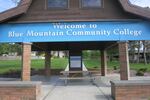In a classroom in the small eastern Oregon town of Stanfield, high school students are punching calculators and calling out answers. They're in Tyler Davis' Math 112 class — a college-level pre-calculus class. It offers each student the chance at earning four college credits. A few years ago, Davis couldn't have done that.

Stanfield Secondary School math teacher Tyler Davis offers Math 112 for college credit, in an Eastern Promise partnership with Eastern Oregon University and local community colleges.
Rob Manning / OPB
Giving high school students the opportunity to earn college credits can be enormously valuable for students like Stanfield sophomore Kaitlyn Burns, because it reduces the cost of obtaining a college degree.
"It's so much more affordable here than actually being in college, and having to pay the full price, so it makes it really happen," Burns said.
Oregon is the state with the worst high school graduation rate in the nation. But in eastern Oregon, graduation rates are routinely higher than the state average. So, eastern Oregon is focused on another issue: Too few of those new high school grads go on to college or training programs.
It's only recently that a teacher like Davis could offer college credits — or that Burns could earn 30 of them by the end of 10th grade. It has taken a united effort between high schools and local colleges, known as Eastern Promise, for that to happen. It is one of a half-dozen ways Oregon schools offer college credit to high school students.
Kris Mulvihill supervises the K-12 side of Eastern Promise. She's often driving Interstate 84, shuttling between schools and colleges.
She says only a few years ago, college credit classes for high school students were rare treasures.

Kris Mulvihill (left) works with high school students at Riverside High School in Boardman. Mulvihill directs the K-12 portion of the Eastern Promise program.
Rob Manning / OPB
"The capacity to offer access to students was very limited, if it existed at all," Mulvihill said.
If a high school offered college credits, students had to know where to look.
"Let's say, Mrs. Brown on one side of the hall is able to offer Biology 101," Mulvihill said. "And let's say across the hall, Mr. Smith teaches bio, but not for college credit.
"In the past, few families would have known about college credits available in Mrs. Brown's class," Mulvihill said. "They were hidden gems. Schools actually had to keep those opportunities - those college-going opportunities - kind of a secret."
The secret opportunities often helped families that already had advantages in the school system. That inequity led to the creation of Eastern Promise to help other teachers offer their classes for college credits too.
Why could some teachers offer college credit, and not others?
Basically, a teacher needed a master's degree in a content area to teach that class for college credit. But Stanfield teacher Davis is like lots of teachers; he has a master's in education, not in math.
Eastern Promise has gotten around the degree requirement by teaming teachers with college and university professors who have the content credentials. The teams agree on the course syllabus, the standards — even how to score exams.
"The neat thing about it is you have teachers from around the region scoring a lot of the student work and creating the assessments, and collaborating also with higher ed. Kids really have to earn it — and not everyone does," said Bryan Johnson, Stanfield's principal.
Classes for college credit go on a student's transcript, so failing can have consequences. Theresa Pihl supervises the Eastern Promise history team, as a professor at Blue Mountain Community College. High school students had their first exam in the new credit-bearing history class in the winter.

Blue Mountain Community College in Pendleton is one of the partner institutions in the Eastern Promise program.
Rob Manning / OPB
"We had a 33 percent pass rate, which we kind of thought 'Ooh.' But, on the other hand, this was the very first time, first time for the teacher, too," Pihl said. "When we looked at his course grades, the students that passed the assessment were his A-B students."
Eastern Promise skeptics are concerned about that failure rate. The Oregon Education Association — the statewide teachers' union — is concerned that it's piling on expectations for students and teachers that already have a lot on their plates.
"I think the failure rate is a problem," said OEA President Hanna Vaandering. "You're adding to the high school curriculum the dual-credit components. It's a high bar to set for the high school students, and the high school educators can't skip any of the curriculum that they have, because that's mandated."
Supporters say expectations rise for the whole class, whether students are taking it for college credit or not.
Students are told they can "withdraw" from the college credit aspect to avoid a black mark on their transcript, but officials don't have good data on how often that happens. Success rates vary widely – with virtually all students passing some classes, and barely half passing others.

Stanfield Secondary School is a small school - with only 223 students in grades 7-12. But through partnerships with local colleges, it offers almost 90 college credits.
Rob Manning
On the upside, 81 percent of seniors with Eastern Promise credits go on to college — compared to the state average of 56 percent. And they save money, at $10 a credit. Multiply that credit cost by thousands of students over the last few years, and Eastern Promise estimates it has has saved families $1.7 million.
Kaitlyn Burns - the Stanfield sophomore with 30 credits - is already planning her education with college costs in mind. She's the daughter of a single mom. At one point, she wanted to grow up to be a psychologist. Then she looked into it.
"It takes a lot of time and I also looked into the job market of it, and it's really competitive. So, I kind of thought about becoming an RN (registered nurse), because there's always a demand for it, and I want to think future-wise," Burns said.
Eastern Promise proponents like Mulvihill would argue that Burns could still become a psychologist, if she changes her mind again.
But Mulvihill suggests Burns is in the right place for now, with the right teachers. "They are, in effect, Stanfield Community College," Mulvihill said.
